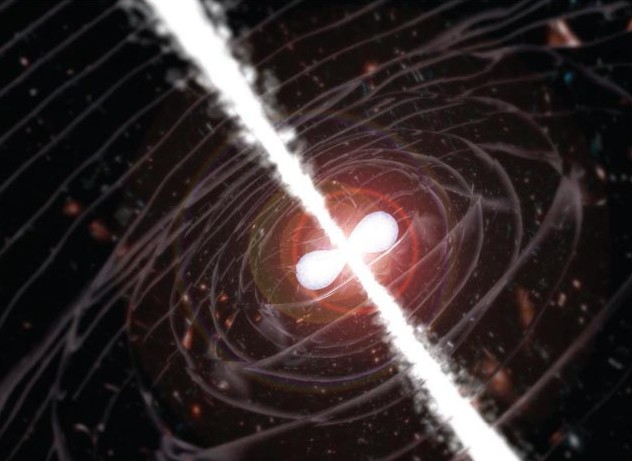(单词翻译:单击)
Gamma-ray bursts, called GRBs for short, are one of the biggest mysteries in modern astronomy.
伽马射线爆发(GRB)是现代天文学里最大的谜题之一。
They're explosions that release tons of highly energetic gamma radiation, but although we know they come from outside the Milky Way, scientists aren't exactly sure how they happen.
GRB会释放出大量高能伽马辐射,但虽然我们知道这些射线来自于银河系之外,但科学家还是不太清楚发生的过程。
They are trying to figure it out, though, especially since these bursts are energetic enough to interfere with satellites and astronauts in space.
科学家正在努力解开这个奥秘,尤其是考虑到这些射线能量之高竟然能够干扰到太空中的卫星和宇航员。
But there's a long way to go. We've spent more than 50 years trying to understand GRBs.
但我们还有很长的路要走。我们已经耗时50多年来弄清楚GRB的奥秘。

And what's especially surprising is that this mystery began on accident, thanks to, of all things, the Cold War.
但尤其令人震惊的是,这个谜题是我们意外收获的,有很多因素促成了这项发现,冷战就是其中的一个。
The story starts in 1963, when the U.S., U.K., and Soviet Union all got together and agreed they wouldn't set off any nuclear bombs in the atmosphere or in space.
故事开始于1963年,那时候,美国、英国和苏联聚集在一起,他们达成一致,称任何一方都不会向大气层和太空中释放核弹。
Of course, since this was right in the middle of the Cold War, it wasn't like everyone was super trusting of each other.
当然了,当时正处于冷战之中,所以任何一方都不会很信任彼此。
So that same year, the U.S. Air Force started launching a bunch of monitoring satellites, collectively called Vela, to help make sure everyone was following the new rules.
于是,同年,美国空军开始发射一系列监测卫星,这一系列卫星统称为船帆座(Vela)。这样做的目的是为了确保每一方都有遵守新的游戏规则。
Vela carried instruments to detect X-rays, gamma radiation, and energetic neutrons.
船帆座上配有很多设备,可以监测到X光线、伽马射线和高能中子。
All things that could be released by a nuclear test.
这些都是核试验中会释放出的东西。
The satellites also always orbited in pairs, so there was never an unobserved hemisphere.
而且卫星总是成对环绕,所以不会错过任何一个半球。
Over the years, they gathered tons of data, and some of it was pretty unexpected.
这些年间,他们收集了大量数据,其中一些数据让他们颇感意外。
In 1967, the Vela 4 satellites picked up two big peaks of gamma radiation:
1967年,Vela 4卫星捕捉到了2个很大的伽马辐射巅值。
first, a tall, sharp one, and then a lower, broader one.
第一个又高又尖,另一个又低又宽。
The good news is, they at least didn't seem to be coming from Earth.
好消息是,至少看起来不像是从地球来的。
Since the satellites operated in pairs, whichever one was closer to a signal would detect it first, and that would help pinpoint its origin.
鉴于卫星都是成对行动的,离得更近的那个会先检测到信号,这样就能确定信号的位置了。
But this time, both satellites got basically the same signal at the same time.
但这一次,这两颗卫星几乎同时收到了相同的信号。
Still, that wasn't anything to stop the presses about.
不过,这也倒没啥。
It was just one event, so maybe the detectors malfunctioned.
这只是一次,或许探测器发生故障了也不一定呢。
But then it happened again. And again.
但这样的事情接二连三地出现了。
In fact, by 1973, Velas 5 and 6 had detected 16 more of these mysterious gamma ray bursts, and scientists knew this was a new phenomenon.
实际上,1973年的时候,Velas5和6又探测到了16个神秘的伽马射线爆发,那时候,科学家就知道这是一种新现象。
But that was about all they knew. Besides “somewhere in space”, it still wasn't clear where these GRBs were coming from.
但他们所知道的也仅限于此。除了“某个地方有之外”,他们依然不清楚究竟是哪里有。
We didn't know if they were from inside or outside the galaxy, and researchers certainly didn't know what was causing them:
我们不知道他们究竟来自星系外还是星系内,而且研究人员也不知道是什么原因引发了这种现象。
Hypotheses covered everything from supernovas to black holes.
各种假说铺天盖地,有说是超新星造成的,有说跟黑洞有关的。
Only in 1996, almost 30 years after the first GRB detection, did we finally make some serious progress in figuring things out.
直到1996年,也就是首次探测到GRB后的近30年,我们才在这件事情上取得了一些实实在在的进展。
That year, the Italian and Dutch space agencies launched BeppoSAX, an Earth-orbiting spacecraft that monitored the skies for objects like GRBs.
1996年,意大利和荷兰空间机构发射了BeppoSAX卫星,该卫星环绕地球飞行,并监测到天空,寻找疑似GRB的物体。
Specifically, it was equipped to detect something called afterglows.
准确的说,它们配备的设备可以识别余辉。
After an object like a star releases a big burst of energy, there's kind of a cool-down period, where you can see a sort of glow in lower wavelengths.
类似于恒星的物体放射出一股巨大能量后,会有一段冷却期,在该时期可以看到波长更短的辉光。
After a GRB, you'd expect an afterglow with X-rays and visible light, which could take about a week to fade.
GRB出现后,可能会看到带有X光线和可见光的余辉,要一周才会消散。
BeppoSAX had wide-field cameras that could pinpoint the location of a burst and send that data to Earth really quickly.
BeppoSAX卫星的摄像头视野很宽,可以确定射电暴的位置,并将数据快速传输给地球。
Fast enough that ground-based telescopes could observe the afterglow.
由于数据传输的速度很快,所以地面上的望远镜可以观测到余辉。
And that technology finally let us pin down the location of a GRB.
这项技术可以让我们确定GRB的位置。
Less than a year after launch, BeppoSAX detected a burst from some 8 billion light-years away.
发射后不到一年后,BeppoSAX卫星探测到了80亿光年外的射电暴。
So, definitely outside the galaxy. And in the years since, we've found plenty of others, all far outside the Milky Way.
所以肯定是在银河系外了。从那以后的这些年来,我们还发现了很多其他的射电暴,都是在银河系外的。
So we know these bursts aren't from around here.
这样我们就知道射电暴肯定不是银河系附近的。
Now, we just need to answer the dozens of other questions.
而现在,我们需要回答的问题还有很多。
Based on the observations we've made since 1967, we think there are actually several types of GRBs out there, varying in intensity and duration.
根据1967年 以来的观测,我们认为,按强度和延续时间来看,GRB其实有好几种。
And that suggests there may not be a single, universal explanation for how they work.
这就表明,他们的运作方式可能并不是单一的,不能一刀切。
It's possible that some might involve supernovas or merging neutron stars the dense cores leftover after a supernova.
很有可能的是:一些GRB包括超新星或者超新星结束后大密度内核残留形成的中子星。
But there's a lot of gray area, and a lot we have left to learn.
还有很多黑色地带和很多需要学习的地方。
To make things more complicated, we'll also never be able to predict GRBs, because we can't know when something like a star is going to die, or when two stars are going to merge together.
让情况更为复杂的是,我们永远无法预测GRB,因为我们不知道恒星之类的物体何时会消亡,也不知道两颗恒星何时会聚合在一起。
Plus, the events that might lead to one of these bursts take place on cosmological time scales.
此外,可能导致射电暴的活动,其时间是按宇宙的标准来衡量的。
Our lives are within the margins of error for these processes.
人一辈子的长短连这些过程的误差值都不到。
If nothing else, though, we do know a decent amount about what happens when gamma rays interact with Earth.
如果没有很多因素的干扰,我们确实知道伽马射线跟地球交互的时候会发生什么。
All our detections of GRBs let us know the kinds of energies we can expect from them, which lets us take any necessary precautions to protect our satellites and astronauts.
我们对GRB的探测让我们知道它们所具有的能量,因此我们会尽可能采取防护措施,保护卫星和宇航员。
And we can extrapolate from those detections and model what might happen if Earth were closer to a burst all of which informs how we understand habitability in the universe.
而且通过这些探测和模型,我们还能推测如果地球离射电暴距离更近的话,可能会发生什么。这些信息都可以让我们了解宇宙的可居住性。
Realistically, we're a long way from solving this Cold War discovery, but we've learned a lot from the journey, too.
从现实的角度来讲,要解决这个源自冷战时期的发现还有很长的路要走,但我们在这条路上已经了解很多了。
Thanks for watching this episode of SciShow Space especially to our amazing patrons on Patreon!
感谢收看本期的《太空科学秀》,尤其要感谢我们的忠实粉丝!
Thanks for helping us explore the mysteries of the universe.
感谢大家帮助我们探索宇宙的诸多奥秘。
If you'd like to support the show and help us keep making episodes like this, you can go to patreon.com/scishow.
如果您想要支持我们的节目,并帮助我们继续制作这类视频的话,您可以登录patreon.com/scishow。


